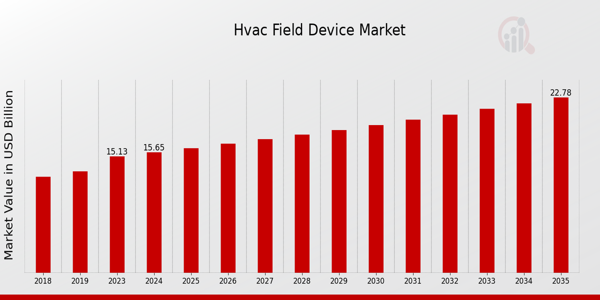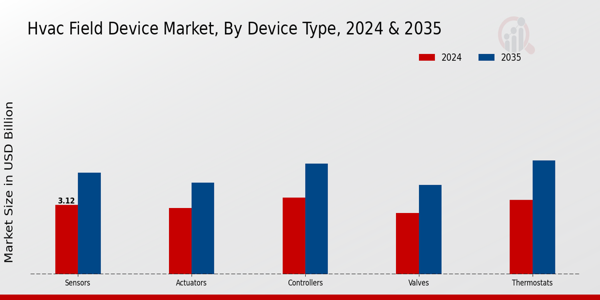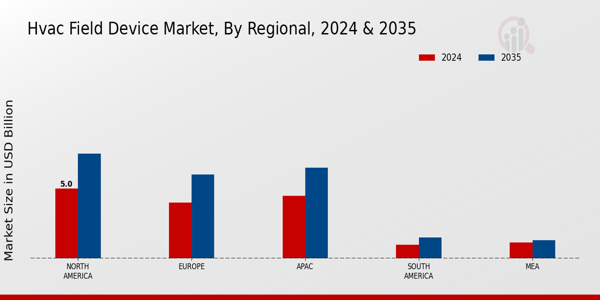Global HVAC Field Device Market Overview
The HVAC Field Device Market Size was estimated at 15.13 (USD Billion) in 2023. The HVAC Field Device Industry is expected to grow from 15.65(USD Billion) in 2024 to 22.8 (USD Billion) by 2035. The HVAC Field Device Market CAGR (growth rate) is expected to be around 3.47% during the forecast period (2025 - 2035).
Key HVAC Field Device Market Trends Highlighted
The HVAC field device market is experiencing significant growth driven by increasing urbanization and the rising demand for energy-efficient solutions. The need for improved indoor air quality and comfort in residential, commercial, and industrial settings is pushing innovations in HVAC technologies. Additionally, stringent regulations aimed at reducing carbon emissions are prompting many businesses to invest in advanced HVAC systems. The integration of IoT and smart technologies is also enhancing device functionalities, contributing to energy efficiency and enabling better system management.
Opportunities in the HVAC field device market are abundant, particularly with the growing acceptance of smart HVAC systems.Organizations can integrate artificial intelligence and machine learning into predictive maintenance techniques in order to minimize downtimes and operational costs. The growing tendency to upgrade available systems gives an opportunity for such companies to capture the market with improved solutions for better performance and sustainability. Moreover, as green building becomes more widespread, there can be a greater focus on producing sustainable technologies.
There is currently a growing trend in HVAC systems for the use of wireless technologies, which do not require so much effort in installation and maintenance. Moreover, there is more focus on mobile app control and user-friendly interfaces to meet the needs of modern consumers.
As remote monitoring and control become standard, the development of cloud-based solutions is gaining traction. This transformation makes HVAC systems more versatile and responsive to user needs, aligning with current lifestyle trends. In summary, the HVAC field device market is on a progressive path, influenced by technological advancements and a growing emphasis on sustainability.

Source: Primary Research, Secondary Research, MRFR Database and Analyst Review
HVAC Field Device Market Drivers
Growing Demand for Energy Efficiency and Sustainability
The HVAC Field Device Market Industry is being significantly driven by the increasing demand for energy efficiency and sustainable solutions in building management. As energy costs continue to rise and environmental concerns gain more prominence, both commercial and residential sectors are actively seeking ways to reduce energy consumption and carbon footprints. HVAC systems are among the largest consumers of energy in buildings, and therefore, enhancing their efficiency has become a top priority. This has led to a surge in the adoption of advanced HVAC field devices that facilitate better monitoring, control, and management of temperature, humidity, and air quality.
These devices are often equipped with smart technologies, such as IoT integration, which enables real-time data analytics and predictive maintenance, thereby enhancing energy savings and operational efficiency. Moreover, governmental regulations and incentives aimed at promoting energy-saving technologies further bolster the demand for such devices. The shift towards green building practices is another critical factor driving the HVAC Field Device Market, as more developers and owners are prioritizing sustainable construction and retrofitting existing buildings with energy-efficient HVAC solutions.
With the market expected to expand significantly over the coming years, it is evident that energy efficiency and sustainability will continue to be key drivers in shaping the future landscape of the HVAC Field Device Market.
Technological Advances and Smart HVAC Solutions
Technological advancements play a pivotal role in propelling the HVAC Field Device Market Industry forward. The integration of smart technologies, including IoT, artificial intelligence, and machine learning, into HVAC systems is revolutionizing the way these devices operate. Smart HVAC solutions allow for better monitoring and automated control of systems, resulting in improved performance and user experience. These advanced systems are equipped with sensors and connectivity features that facilitate real-time data collection and analysis, leading to enhanced predictive maintenance and reduced downtime.
The growing popularity of smart home technology and automation is driving demand for HVAC devices that seamlessly integrate with other smart home systems, further contributing to market growth. As consumers focus on convenience, energy savings, and improving indoor air quality, the trend toward smart HVAC solutions is expected to accelerate, making it a significant driver for the HVAC Field Device Market.
Increasing Urbanization and Infrastructure Development
Rapid urbanization and infrastructure development across various regions are significantly influencing the HVAC Field Device Market Industry. As populations move to urban areas, the demand for residential and commercial buildings rises, thereby increasing the need for effective HVAC solutions. New construction projects, along with renovations of existing buildings, create opportunities for implementing modern HVAC field devices that can provide better control and energy efficiency. Furthermore, governments and private sectors are investing heavily in infrastructure projects, including the development of smart cities and commercial complexes, which require advanced HVAC technologies.
This trend of urbanization combined with infrastructure growth is projected to sustain the demand for HVAC field devices, driving market expansion in the coming years.
HVAC Field Device Market Segment Insights
HVAC Field Device Market Device Type Insights
The HVAC Field Device Market is a significant sector that showcases its diversity through various device types, creating a robust landscape for industry growth and innovation. In 2024, the market is projected to be valued at 15.65 USD Billion, with a steady progression expected in the coming years. Among the device types, Sensors are a major holding, valued at 3.12 USD Billion in 2024 and projected to grow to 4.56 USD Billion by 2035, reflecting their crucial role in monitoring and controlling environmental parameters effectively.
This high valuation is indicative of the increasing demand for precision in temperature and humidity control within HVAC systems, making Sensors an essential component for improving energy efficiency and operational reliability. Actuators closely follow, valued at 2.98 USD Billion in 2024, with an expected rise to 4.12 USD Billion in 2035, showcasing their importance in automating the operation of HVAC systems by controlling airflow and temperature adjustments based on real-time data.
Controllers are another significant component of the device type segment, with a current valuation of 3.45 USD Billion in 2024, set to enhance the automation capabilities of HVAC systems, as they serve as the brain managing the interactions between other devices. This segment's importance is mirrored by its anticipated rise to a valuation of 4.98 USD Billion by 2035.
Valves also play a significant role in the operational integrity of HVAC systems, valued at 2.75 USD Billion in 2024 and projected to reach 4.02 USD Billion by 2035; their function in regulating liquid and gas flow underlines their necessity for inefficient HVAC performance. Finally, Thermostats, held at a valuation of 3.35 USD Billion in 2024 and expected to climb to 5.12 USD Billion in 2035, continue to evolve with smart technology integration, driving demand through enhanced user control and energy savings.
Overall, the HVAC Field Device Market segmentation into these device types illustrates a trend toward increased automation and energy efficiency, supported by ongoing technological advancements. Each device type plays a unique and relevant role in the efficiency and control of HVAC systems, highlighting their transformative potential in the industry. As the market progresses, the ongoing integration of smart technologies, such as IoT-enabled devices, is likely to further enhance their value propositions, presenting opportunities for innovation and investment within the HVAC sector.
The evolving landscape signals a promising future across all segments as organizations look to optimize their HVAC solutions for sustainability and performance.

Source: Primary Research, Secondary Research, MRFR Database and Analyst Review
HVAC Field Device Market Application Insights
The HVAC Field Device Market is projected to reach a value of 15.65 USD Billion by 2024, showing a steady growth trajectory driven by increasing demand for efficient heating, ventilation, and air conditioning systems across various applications. The market segmentation highlights three primary areas: Residential, Commercial, and Industrial.
The Residential sector typically requires HVAC devices for maintaining comfort and air quality in homes, while the Commercial sector utilizes these devices to create optimal work environments in offices, retail spaces, and public buildings.The Industrial segment is crucial as businesses rely on HVAC systems for process cooling and maintaining specific climate conditions for manufacturing. With the market data demonstrating a consistent progression, the growth of smart home technologies and the need for energy-efficient solutions are significant drivers behind the increased adoption of HVAC devices. However, challenges such as regulatory compliance and the high initial investment costs may affect market expansion.
Overall, the HVAC Field Device Market statistics underscore the importance of understanding application needs to capitalize on opportunities for innovation and efficiency in each sector.
HVAC Field Device Market Technology Insights
The HVAC Field Device Market, valued at 15.65 billion USD in 2024, showcases a robust growth trajectory influenced by ongoing technological advancements. The market is segmented into various technologies, prominently featuring Wired, Wireless, and Smart solutions. Wired technologies have traditionally been the backbone of communication in HVAC systems, known for their reliability and stability, ensuring seamless data transmission.
In contrast, Wireless technologies have gained traction due to their flexibility and ease of installation, catering to the growing demand for retrofitting and upgrading existing systems without extensive rewiring.Smart technologies play a significant role in modern HVAC systems, incorporating IoT capabilities to enhance efficiency and enable remote monitoring and control, ultimately boosting energy savings. The preferences for these technologies reflect a shift towards energy-efficient and user-friendly systems spurred by rising energy costs and environmental concerns.
Insights into the HVAC Field Device Market revenue indicate a comprehensive understanding of the market dynamics, revealing how advancements in technology contribute to the overall market growth.The continuous evolution in this sector also presents opportunities for innovation and improved performance in HVAC systems, ensuring that businesses can adapt to changing consumer needs and regulatory demands.
HVAC Field Device Market End Use Insights
The HVAC Field Device Market, with its focus on End Use, encompasses critical applications in Heating, Ventilation, and Air Conditioning, each playing a vital role in enhancing indoor environmental quality. By 2024, the overall market is projected to be valued at approximately 15.65 USD billion, showcasing the industry's significance. The Heating aspect is crucial as it provides comfort in colder climates, significantly driving demand for sophisticated field devices.
Ventilation ensures adequate air quality, making it indispensable for health and safety, especially in commercial buildings.Air Conditioning remains a major contributor to the market, catering to consumer demand for comfort in warmer regions, thus holding a significant share of overall market revenue. The HVAC Field Device Market Statistics indicate that as energy efficiency and smart technology adoption rise, this segment is expected to witness consistent growth. The integration of IoT in HVAC systems presents new opportunities, while challenges such as regulatory compliance and initial investment costs need to be addressed.
Overall, the HVAC Field Device Market segmentation will continue to evolve, driven by innovations and the growing awareness of energy savings and sustainability in building management.
HVAC Field Device Market Regional Insights
The HVAC Field Device Market shows significant regional variations, with North America leading in market valuation at 5.0 USD Billion in 2024 and projected to reach 7.5 USD Billion by 2035, reflecting strong demand for energy-efficient solutions and smart building technologies. Europe follows closely, valued at 4.0 USD Billion in 2024, expected to rise to 6.0 USD Billion, driven by stringent regulations and advancements in technology.
The APAC region, crucial for growth, is valued at 4.5 USD Billion in 2024 and is anticipated to reach 6.5 USD Billion, benefiting from rapid urbanization and industry expansion.South America holds a smaller share at 1.0 USD Billion in 2024, rising to 1.5 USD Billion, influenced by growing infrastructure investments. The MEA region stands at 1.15 USD Billion in 2024, with a slight increase to 1.3 USD Billion, where market growth is driven by the construction of energy-efficient buildings.
Overall, North America and Europe dominate in terms of revenue, showcasing significant market trends driven by technology advancements and energy efficiency imperatives, while APAC is emerging as a vital player with its robust growth potential.

Source: Primary Research, Secondary Research, MRFR Database and Analyst Review
HVAC Field Device Market Key Players and Competitive Insights
The competitive landscape of the HVAC Field Device Market is characterized by rapid technological advancements and a growing emphasis on energy efficiency and sustainability. Numerous players are vying for market share, leading to innovations that enhance the functionality and reliability of HVAC systems. Strategic alliances, research and development initiatives, and mergers and acquisitions are pivotal in maintaining a competitive edge. As the demand for advanced heating, ventilation, and air-conditioning systems continues to rise across various sectors, such as residential, commercial, and industrial applications, companies are focusing on a diversified product portfolio to cater to the evolving needs of end-users.
The market dynamics are shaping the way businesses operate, compelling them to align their offerings with emerging trends such as smart home integration and Internet of Things (IoT) technologies.Mitsubishi Electric holds a significant position in the HVAC Field Device Market, leveraging its technological prowess and a well-established reputation for quality and reliability. The company excels in providing a wide range of HVAC solutions, including advanced control systems, variable refrigerant flow systems, and energy-efficient equipment.
Its commitment to innovation is reflected in its comprehensive product offerings that not only meet regulatory standards but exceed customers' expectations in terms of performance and environmental sustainability. Mitsubishi Electric's extensive global presence further enhances its competitive advantage, allowing it to deliver localized solutions tailored to specific market requirements. The robust research and development framework within Mitsubishi Electric enables the company to continuously evolve its product line, ensuring alignment with industry trends and customer demands.Bosch is another formidable player in the HVAC Field Device Market, recognized for its extensive expertise in engineering and technology.
The company's HVAC systems are designed with a strong focus on comfort, efficiency, and smart building technologies, making them an attractive choice for both residential and commercial applications. Bosch's commitment to sustainability is evident in its development of energy-efficient devices and renewable energy solutions that target the growing demand for greener HVAC systems. The company's global footprint ensures that it can cater to diverse markets, while its strong brand recognition contributes to customer trust and loyalty.
Continuous investment in innovation allows Bosch to maintain its competitiveness and expand its product offerings, addressing the evolving needs of consumers and stakeholders in an increasingly integrated and technology-driven market environment.
Key Companies in the HVAC Field Device Market Include
HVAC Field Device Market Industry Developments
Recent developments in the HVAC Field Device Market reflect a growing focus on sustainability and energy efficiency, with key players like Mitsubishi Electric and Bosch advancing their offerings in smart technology and IoT integration. Trane Technologies has expanded its product line to include energy-efficient systems aligned with regulatory standards. Siemens is actively investing in digital solutions, enhancing operational efficiency, while Emerson Electric continues to innovate in automation technologies to optimize HVAC performance.
In terms of mergers and acquisitions, Carrier has pursued strategic partnerships to bolster its market presence, and Danfoss has been reported to engage in various integrations to expand its portfolio. Honeywell and Johnson Controls are also consolidating their market positions through investments in smart building technologies. The market is witnessing significant growth as corporations increasingly recognize the importance of HVAC solutions in achieving sustainability goals and regulatory compliance, thereby enhancing overall market valuation.
This surge in valuation is anticipated to drive further innovations and competitive strategies among established companies such as Panasonic, Lennox International, and Schneider Electric, positioning them as leaders in the evolving landscape of HVAC field devices.
HVAC Field Device Market Segmentation Insights
HVAC Field Device Market Device Type Outlook
HVAC Field Device Market Application Outlook
HVAC Field Device Market Technology Outlook
HVAC Field Device Market End Use Outlook
HVAC Field Device Market Regional Outlook
|
Report Attribute/Metric
|
Details
|
|
Market Size 2023
|
15.13 (USD Billion)
|
|
Market Size 2024
|
15.65 (USD Billion)
|
|
Market Size 2035
|
22.8 (USD Billion)
|
|
Compound Annual Growth Rate (CAGR)
|
3.47% (2025 - 2035)
|
|
Report Coverage
|
Revenue Forecast, Competitive Landscape, Growth Factors, and Trends
|
|
Base Year
|
2024
|
|
Market Forecast Period
|
2025 - 2035
|
|
Historical Data
|
2019 - 2024
|
|
Market Forecast Units
|
USD Billion
|
|
Key Companies Profiled
|
Mitsubishi Electric, Bosch, Trane Technologies, Panasonic, Siemens, Emerson Electric, NEC, Schneider Electric, Carrier, Lennox International, KMC Controls, Johnson Controls, Danfoss, Honeywell, Hitachi
|
|
Segments Covered
|
Device Type, Application, Technology, End Use, Regional
|
|
Key Market Opportunities
|
Energy-efficient technology integration, Smart home HVAC solutions, IoT-enabled field devices, Growing demand in emerging markets, Regulatory compliance and sustainability initiatives
|
|
Key Market Dynamics
|
Technological advancements, Increasing energy efficiency regulations, Growing demand for smart HVAC systems, Rising construction activities, Shift towards IoT integration.
|
|
Countries Covered
|
North America, Europe, APAC, South America, MEA
|
Frequently Asked Questions (FAQ):
The Global HVAC Field Device Market is expected to be valued at 15.65 USD Billion in 2024.
By 2035, the Global HVAC Field Device Market is anticipated to reach a value of 22.8 USD Billion.
The expected CAGR for the Global HVAC Field Device Market from 2025 to 2035 is 3.47%.
North America is expected to have the largest market size, valued at 7.5 USD Billion by 2035.
The market size for HVAC sensors is projected to be 4.56 USD Billion by 2035.
Some key players in the market include Mitsubishi Electric, Bosch, Trane Technologies, and Honeywell.
The value of HVAC controllers is expected to be 3.45 USD Billion in 2024.
The HVAC actuator market is expected to grow to 4.12 USD Billion by 2035.
The market size for HVAC thermostats is expected to reach 5.12 USD Billion by 2035.
South America has the smallest market size, valued at 1.0 USD Billion in 2024.

















